Fix: Scheduling Assistant Free/Busy Data could not be retrieved
Outlook’s Scheduling Assistant fails in the retrieval of free/busy data mainly because of wrongly configured user permissions. Also, corrupted autocomplete cache or wrong server configuration can cause the error as well. This problem indicates that when scheduling a meeting, the inviting user cannot access the calendar of the person to be invited and the Free/Busy data couldn’t be retrieved. The information for the users, whose data could not be retrieved, will be shown as slashed marks in the scheduling assistant.
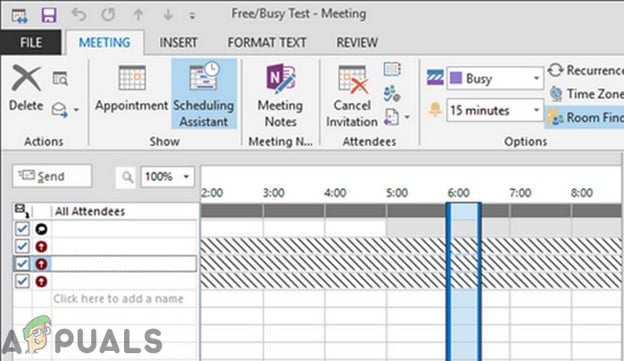
Pre-requisite
- If the problem appeared after a recent Windows/Office update, then uninstall that update.
- Make sure that the users in question had accepted or declined an appointment, otherwise the calendar availability will not be shown.
- Use OWA to schedule the meeting, if it is having issues in OWA, then most probably the issue is server-side related. In that case, contact your I.T Administrator.
- Make sure the user whose calendar is not shown, has not set his calendar time for that period as “Working Elsewhere”.
This error message is usually solved instantly using the methods listed below given that there are no restrictions from the organization itself (if you are using a linked account with an organization). If you are, you should consult with your IT department.
1. Set Availability Timing as Per Organization’s Working Hours
Some users unintentionally set their availability timing outside their organization’s office timing, which can result in the failure of scheduling assistant to retrieve free/busy information. For example, an organization working hours are 09:00 AM to 05:00 PM whereas the user has set his availability timing 06:00 PM to 02:00 AM then free/busy data of that user will be slashed marked for the meeting time (if the meeting is being held in organization’s working hours). In that case, setting the timing of that user, as per the organization’s office timing, may solve the problem. This step should be taken on the systems of both users (inviting and to be invited).
- Launch Outlook, then click on the File menu and click on Options.
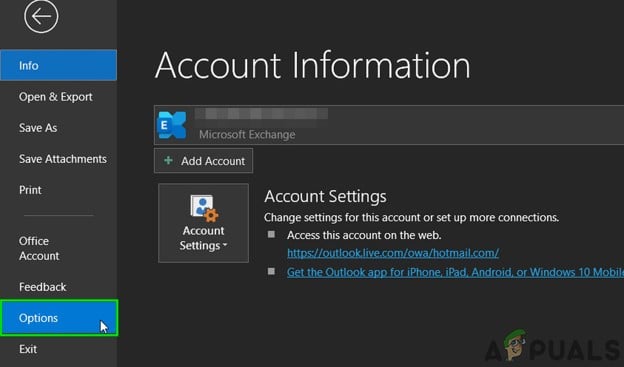
Open Outlook Options - Now in the left pane of the window, click on the calendar.
- Now in the work time section, adjust the timing and working days as per your organization’s working schedule.

Change Work Time in Outlook Calendar - Now restart Outlook and check if the scheduling assistant is working fine.
2. Use Online Mode
Outlook communicates with an Exchange Server either by Cached Mode or Online Mode. In the cached mode, Outlook locally saves a copy of the user’s Exchange mailbox. If Outlook is having sync issues in cached mode then it can cause the current problem of scheduling assistant. In that case, changing Outlook’s connection mode to Online may solve the problem. This step should be taken on the systems of both users.
- Open Outlook and click on File menu
- Then click on the Account Settings drop-down button and again click on Account Settings.

Open Account Settings - In the Email tab, select the account and then click on “Change”.

Change Email Account Settings - Then in the Exchange Account Settings window, click on More Settings.
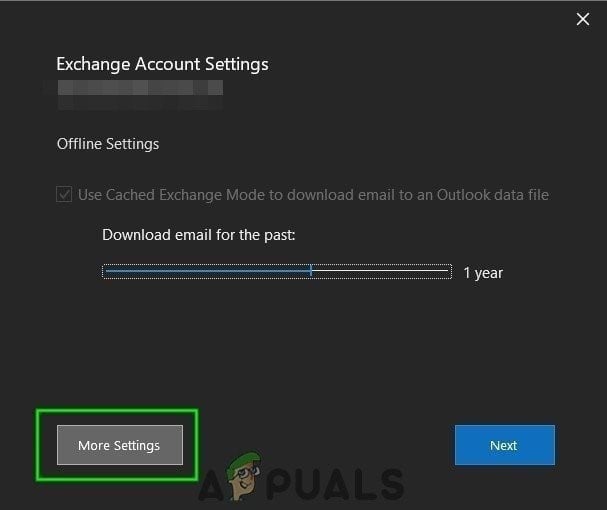
Open More Settings of Account Outlook - Go to the Advanced tab and then Uncheck the checkbox of “Use Cached Exchange Mode”

Uncheck Cached Mode - Now, restart Outlook and check if free/busy information can be retrieved without any issue.
3. Change the Calendar’s Permissions
When a user has set his Calendar Permission to None/Contributor, other people will not be able to see his Free/Busy information. In case only one user’s free/busy information could not be retrieved then it could be the result of the incorrect setting of his calendar permission. In that case, setting permission for his Outlook calendar to Free/Busy time or Free/Busy time, subject, location may solve the problem. This step will be taken at the system of the user whose free/busy schedule could not be retrieved.
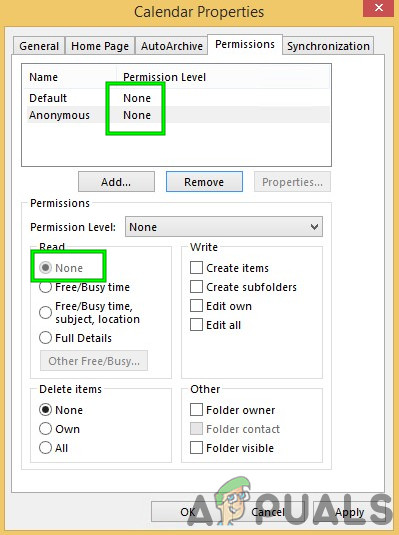
- Open Outlook and click on Calendar.
- Now right-click on the default Calendar, then click on Properties.
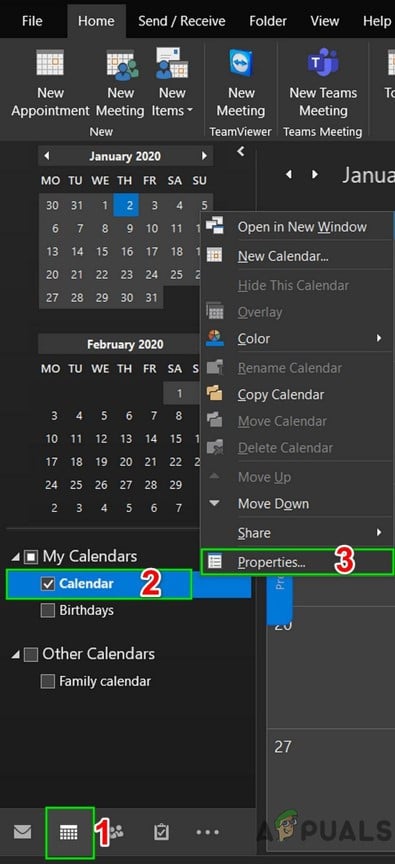
Open Outlook Calendar Properties - Now go to the Permissions
- Switch the permission to Free/Busy time or Free/Busy time, subject, location.

Change Calendar Permissions to Free Busy Time - Now click on the Add button and give the user, who is scheduling, the permission of “reviewer”.
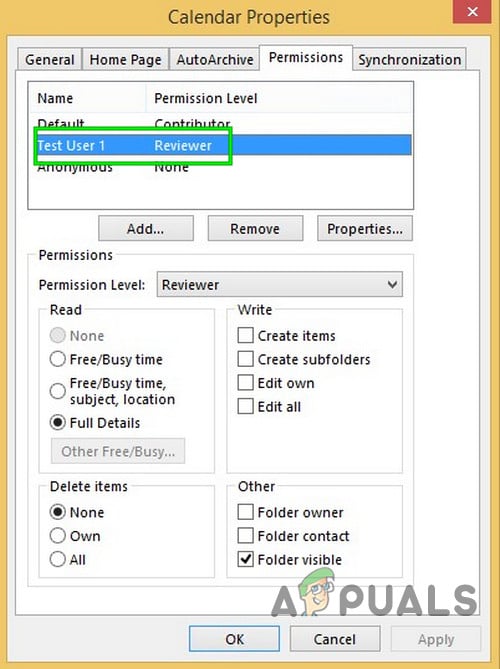
User Permission Set to Reviewer - Now Restart Outlook and check if the scheduling assistant has started to work normally.
4. Clear the Auto-Complete List
Autocomplete is an excellent feature of Outlook. It stores the name of the user you have contacted before and when you start typing the name of the user, it will start to show you suggestions to choose from. But this cache sometimes gets corrupted and causes many sorts of problems including the problem of scheduling assistant you are facing presently. In that case, clearing the Autocomplete cache may solve the problem. This step should be taken at the system of the user who cannot retrieve free/busy information.
- Launch Outlook and click on New items and then on meeting.
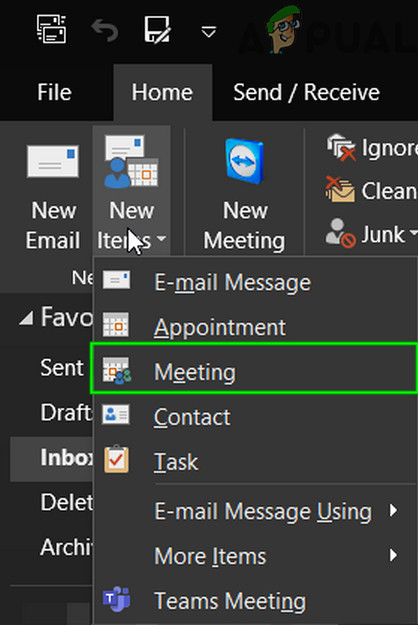
Create New Meeting in Outlook - Now start typing the name of the user that has issues.
- You will see a dropdown/autocomplete of the user’s name (assuming they’ve you have contacted them before). Now click the “X” on the right side of the dropdown item to delete the concerned Autocomplete entry.
- Close the Meeting invitation without saving.
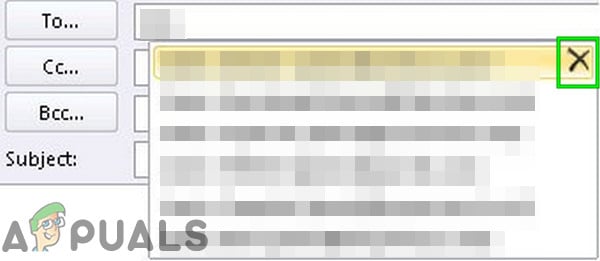
Delete Autocomplete Entry - Restart Outlook.
- Now create a new Outlook meeting and type the problematic user’s full email address (you can also use the Check Names button to have it check against GAL) and then click on the Scheduling Assistant to check if you can view free/busy schedule.
- If not, then clearing the complete cache of autocomplete may solve the problem. To do so, click on the File menu and then click on Options.

Open Outlook Options - Now in the left pane of the Options window, click on Mail.
- Then in the right pane of Window, scroll down and just click the Empty Auto-Complete List. Click yes, if prompted for confirmation.

Empty Auto-Complete List - Now restart Outlook and then check if you can view free/busy information in scheduling assistant.
5. Disable Antivirus/Firewall
Firewall and Antivirus help us protect in the nearly lawless world of the worldwide web. These applications have a known history of non-compatibility with Outlook. That can be the reason for non-retrieval of free/busy schedule especially if Outlook is working fine in OWA but having issues in cached and online mode. This step should be taken on the systems of both the users.
Warning: Use this solution at your own risk as disabling/changing your firewall/antivirus settings will make your system more vulnerable to many threats of malicious, fraudulent or viral attacks. This step is not recommended by us.
- Exit Outlook.
- Disable Anti-Virus.
- Disable Firewall.
- Launch Outlook and check if free/busy information can be retrieved.
Afterward, do not forget to enable Anti-Virus and Firewall. If you were able to retrieve free/busy information successfully then make an exception in the Anti-Virus/Firewall to allow Outlook to communicate with the server.
6. Clear Cached Credentials
Windows uses Credential Manager as a “digital locker” to store log-in credentials like usernames, passwords, and addresses. This data is then used by Windows itself or by apps and programs like Microsoft Office etc. Credentials are divided into two basic categories; Windows Credentials and Web Credentials. If these credentials have corrupted then the user may encounter the error under discussion. In that case, removing Outlook related entries from the credentials may solve the problem. This step should be taken at the systems of both the users.
- Exit Outlook.
- Press Windows key, then type Credentials Manager and click on Credentials Manager.
- Now click on Windows Credentials and then search for Outlook related entries. Do not forget to check Office entries as well. Then click on remove, one by one, on all Outlook related entries.
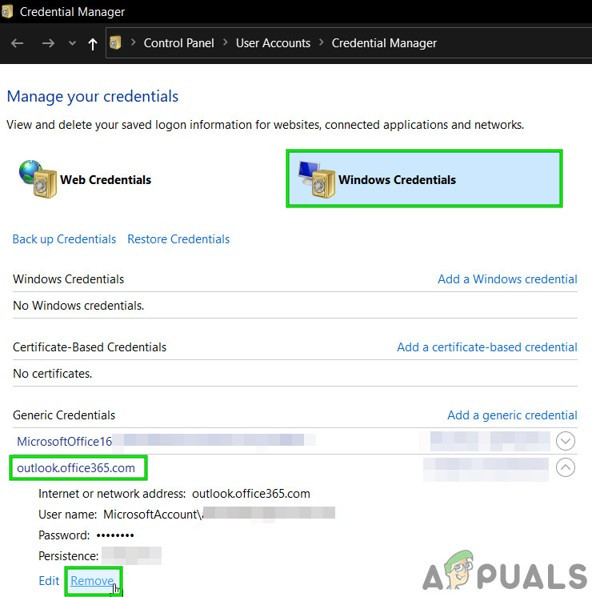
Change Windows Credentials - Now Launch Outlook, then sign-in with your credentials and check if the scheduling assistant is showing free/busy information.
7. Use Outlook in Safe Mode
Add-ins help you to perform a certain operation right from your inbox. But sometimes these Add-ins start to create hindrance in the legitimate operation of Outlook. The add-in of iCloud is known to create the current problem. In that case, using Outlook’s built-in Safe Mode(in which Outlook runs without these add-ins) may solve the problem.
- Exit Outlook.
- Press Windows key, type Run and then in the resulting list, click on Run to open Run command box.
- Type Outlook.exe /safe (There is a space after Outlook and the /)and then click OK. Use full path to Outlook.exe if Windows can’t find Outlook.exe /safe.
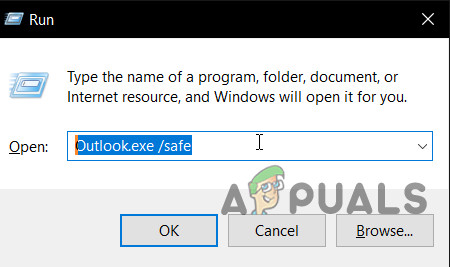
Open Outlook in Safe Mode
Now check if scheduling assistant is showing free/busy information. If it is, then disable Outlook Add-ins one by one by using the following steps
- Open Outlook in normal mode, then click on the File tab and in the left pane of the backstage view, click on Options.

Open Outlook Options - Go to Add-Ins.

Open Add-ins in Outlook Options - Locate the “Manage” dropdown button (located near the bottom of the window) and select the type of add-ins you would manage like COM Add-ins and then click on “Go”.
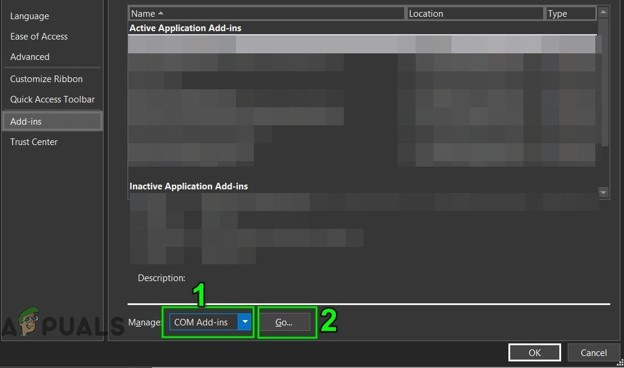
Manage Outlook Add-ins - Now uncheck all the Add-in and restart the Outlook and check if you can still view free/busy information in scheduling assistant. If so, then enable add-ins one by one to find out the problematic one and then keep it disabled. Now visit the developer’s site of the add-in to check for an updated version of that problematic add-in, if present, then install that updated version to check if it solves the problem.
8. Regenerate the OST File
The failure of scheduling assistant to retrieve free/busy information can be a result of sync failure due to corruption of OST file. In that case, creating a new OST file may solve the problem. This step should be taken at the systems of both users.
- Launch Outlook, then click on File
- Now click on Account Settings, then in the drop-down list again click on Account Settings.

Open Account Settings - Now click on data files, then select the user file and click on “Open File Location”.

Open OST File Location - Now keep that folder open and exit Outlook.
- Now, in the opened folder, right-click the OST file. Then click on “Rename” and then change the extension of the OST file to “.old”.
- Now Launch Outlook and the OST file will be regenerated, then check if the free/busy information can be retrieved.
9. Change Server Configuration
It is different server settings that allow users to use different features like viewing free/busy data. If any of these settings are not in place then the users may suffer from the present problem. There are a lot of settings to tweak from but mainly Autodiscover, EWS, and mailboxfolderpermission are the ones which can cause this problem.
Outlook uses Autodiscover to get Free/Busy information and if Autodiscover is configured properly, then free/busy data will be displayed as gray slashes. Make sure if Out of Office assistant is working properly. If not, then most probably Autodiscover service in Exchange is not configured properly since these two symptoms (Out of Office not working and failure of scheduling assistant to retrieve free/busy data) are common when Autodiscover is not configured correctly.
Also, Exchange Web Services (EWS) allows programs to access calendars, contacts, and email. If EwsAllowOutlook setting is configured to $false then it may result in the non-retrieval of free/busy information in scheduling assistant of Outlook. Changing EwsAllowOutlook to $true may solve the problem.
Moreover, wrongly configured mailboxfolderpermission can cause the error at hand.
- Check Outlook Autodiscover connectivity.

Check Outlook Autodiscover Connectivity - Check your Autodiscover EWS and Autodiscover in Exchange
- Reset EwsAllowOutlook to true.
- Run mailboxfolderpermission commands to add the user to the folder permissions.
- Then check if you can view the free/busy information in scheduling assistant.
10. Repair User Profile
Corrupted profile of the user can cause the failure of scheduling assistant to retrieve free/busy information. In that case, repairing the account profile may solve the problem.
- Launch Outlook, then click on the File menu.
- Now click on the drop-down button of Account Setting, then again click on Account Settings.

Open Account Settings - Now in the Email tab, select the user profile and then click on Repair.
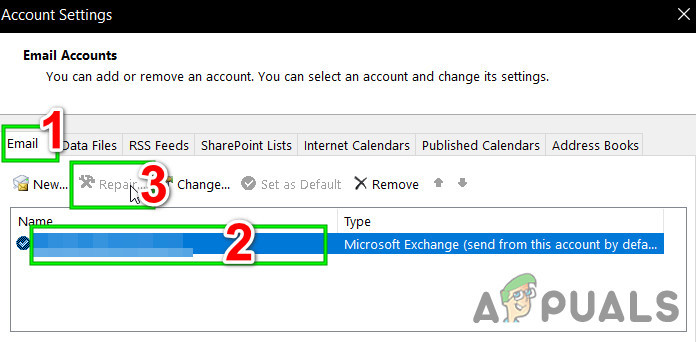
Repair Account Profile - After completion of the repair process, relaunch Outlook and check if free/busy information can be viewed.
11. Create a New User Profile
Failure in the retrieval of free/busy information could occur due to a corrupted/wrong configuration of the user profile. In that case, deleting the current profile and creating a new one may solve the problem. Do note that by doing this, you will completely delete your Outlook profile, and you have to create a new one and reconfigure your connection.
- Exit Outlook.
- Click on the Windows key and in the search box, type Control Panel. Then in the results displayed, click on Control Panel.
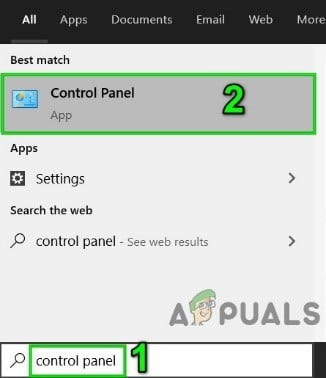
Open Control Panel - Change Category to Large Icons.
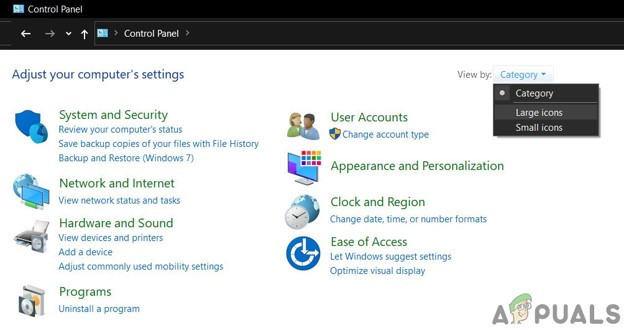
Change Category to Large Icons - Then click on Mail.

Open Mail in Control Panel - Now in the Mail Setup, click on Show Profiles.

Show Profiles in Mail Setup - Then select the Outlook profile and click on the Remove button to remove the current profile.

Remove Outlook Profile From Mail - Then add a new profile.
- Now open Mail in Control Panel (repeat steps 1-5).
- Now in the Mail, choose the newly created Outlook profile and select the radio button of Always use this profile.
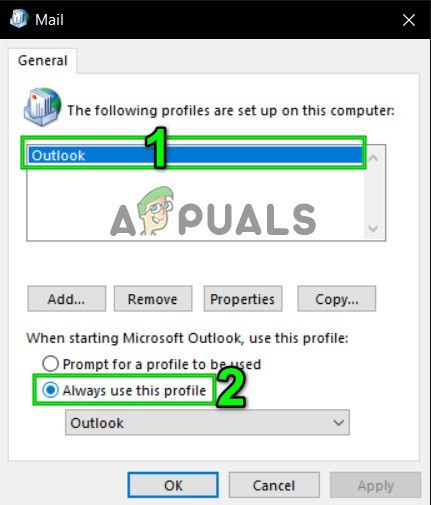
Enable Always Use This Profile - Now click on Apply and then on OK.
- Relaunch Outlook.
Hopefully, you can now use the scheduling assistant without any issue. If not, then use Outlook Web App (OWA).





